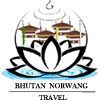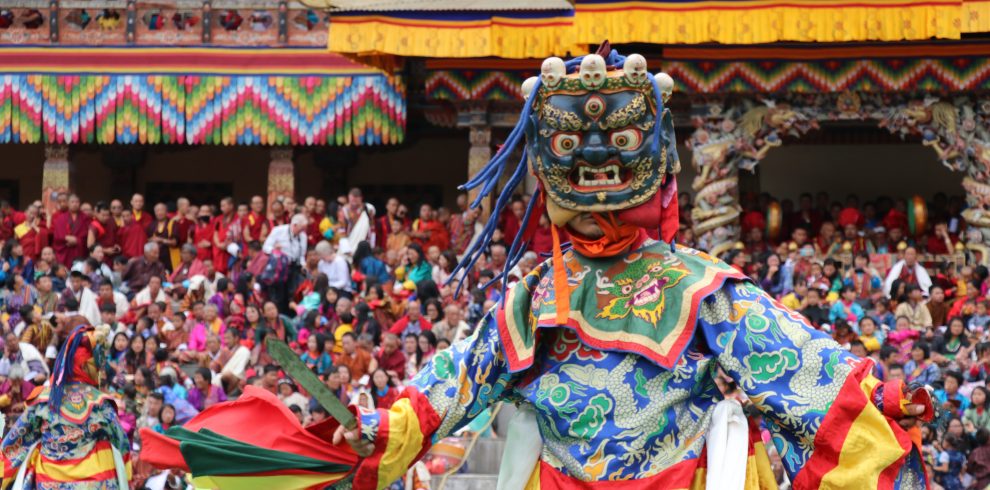This is one of the rarest and most unique local festivals in Bumthang. This three days festival offers the experience of the Buddhist tradition in a setting of unique architecture, and breathtaking Himalayan landscape. The friendly Bhutanese people share with you their traditional lifestyle untouched by outside influence. A trip gives you unique opportunity to experience Himalayan Buddhist culture.
Flying in to the country’s only airport, in the beautiful Paro valley, the clear mountain air, forested ridges, imposing monasteries and welcoming Bhutanese people in their striking national dress, provides a breath-taking first impression. On arrival at Paro airport, after immigration and custom formalities, your guide from Bhutan Norwang Travel will welcome you and transfer you to the hotel. In the evening, you can stroll along Paro downtown to see the people and the local stores.
Overnight- Tandiling Resort
Today we hike up to the famous cliff-hermitage called Taktsang, the “Tiger’s Nest.” This monastic retreat is built into a sheer cliff face high above the Paro valley. Legend has it that the Tibetan Buddhist saint Padmasambhava flew across the Himalayas on the back of a tiger and landed here, bringing Buddhism to Bhutan. The trail to the monastery climbs through beautiful pine forest and an occasional grove of fluttering prayer flags.As you know, normally we go up to the Tiger’s Nest and then turn back but if you like I don’t mind walking extra miles with you. After Tiger’s Nest, we can climb to the temples that are on top of the ridges further up. It’s so peaceful on top and the views are stunning. A perfect place of contemplation! Here you will come across some monks who have not gone down to town for ages – knowing the real nature of this world. There is one elderly monk in particular who had been living here for 25 years in solitude. Perhaps! Depending on if he is not under meditation, we can take some prayer flags and request him to perform a consecration ceremony. To come back, we follow a different path that takes us through the pristine thick forest of oaks and rhododendrons festooned with Spanish mosses.Overnight – Tandiling Resort
This morning, take a drive to Thimphu following Pa Chhu downstream till Chuzom where the two rivers meet, and here you can see the three different styles of stupas or chorten commonly found in Bhutan: Nepalese, Tibetan and Bhutanese. The chortens are Buddhist reliquaries, memorials to the teachings of the Buddha. Sometimes actual relics of the Buddha or revered monks are inserted into the dome of the stupa, but whether or not there are relics inside, the stupas mark the landscape with reminders of the Buddha’s teachings. From here, the road follows Thim Chhu and slowly the valley begins to widen as you get nearer to Bhutan’s capital city. Thimphu has a special charm and it is fascinating to sit and watch a gathering of local people in the town square, wearing their traditional dress and going about their business in a typically unhurried Bhutanese way.You can have free afternoon on your own to walk along the street to see the people and the local stores.
Overnight – Hotel Jhomolhari
Visit weekend market which takes place from Friday till Sunday evening. This certainly offers the best opportunity to see people from remote places come to sell their agricultural products.
Later, drive to Punakha and one of the highlights of the journey is at DochuLa (3050m), the highest point between Thimphu and Punakha. It provides a spectacular view of the Himalayas to the north when the sky is clear, and it is marked with numerous chortens. In Punakha, we will visit the Dzong that was built by Shabdrung, in 1637, on a strategic place at the confluence of PhoChhu and MoChhu rivers. The Dzong has played a hallowed role in the history of Bhutan. It served as the seat of Shabdrung’s government, several foreign delegations were received here in 18th and 19th century, the election and coronation of the first King was observed in 1907 and the Third King convened the first National Assembly in the Dzong. The central monastic body continues to reside here in winter. The embalm bodies of Shabdrung Ngawang Namgyal and Terton Pema Lingpa are housed on the top floor of the main tower. Damaged by four catastrophic fires and an earthquake, the Dzong has been fully restored by the present King from the latest fire in 1987.
Overnight – Hotel YT
After breakfast, drive to Wangduephodrang and visit the Dzong which is perched on a spur at the confluence of two rivers. The position of the Dzong is remarkable as it completely covers the spur and commands an impressive view both up and down the valley. Wangdue district is famous for its fine bamboo work, stone carvings, and the slate which is mined up the valley a few kilometers from the town.
Then drive up a winding mountain road through oak and rhododendron forest, and over a high pass down into the Phobjikha valley, surely one of the loveliest high altitude valleys in Bhutan. Phobjikha is one of Bhutan’s few glacial valleys, and chosen winter home of black necked cranes, migrating from the Tibetan plateau. Explore Phobjikha valley and also visit Gangtey Gonpa (Monastery), the only Nyingmapa monastery in western Bhutan.
Overnight- Hotel Dewachen
Today we drive across Pele-la (3,300m), the traditional boundary between western and eastern Bhutan right on the western edge of Black Mountain National Park. Further down the road, stop to visit Chendebji Chorten erected in the 18th century by a Tibetan lama to cover the remains of an evil spirit that was subdued at this spot. It is built in the Nepalese style, with painted eyes at the four cardinal points.
The landscape around Trongsa is spectacular and its impressive Dzong, stretched along a ridge above a ravine, first comes into view about an hour before the winding road suddenly leads you into the town. We will visit the massive Tongsa Dzong. It was Shabdrung’s great – grandfather who founded the first temple at Tongsa in 1543. In 1647 the Shabdrung had begun his great work of expansion and unification, realizing all the advantages that could be gained from Tongsa’s position; he constructed the first Dzong at the place where his ancestors had erected the temple. The Dzong was called Choekor Rabtentse. In 1652, Minjur Tenpa, the Penlop of Tongsa, had the Dzong enlarged. The Dzong is built in such a way that in the old days, no matter what direction a traveler comes from, he was obliged to pass through the courtyard of the Dzong. This helped to make the Penlop of this Dzong as powerful as it had a complete control over the east – west traffic. The watch tower above the Dzong further strengthened its defense. The father of the first king known as the black regent and the first king served as the Governor of Tongsa before the emergence of the Bhutanese Monarchy, since then it has become a tradition for the young crown prince to serve as the Governor of this place before he is crowned. After visit to the courtyard of the dzong we continue our drive to Yotung La (3425m). With half an hour drive we reach Chumi, the first of the four valleys in Bumthang, and find out a nice spot to have picnic lunch. On our further drive to Bumthang, we will make a brief stop at Zugney Village, where we will see the weavers weaving the famous Bumthang fabric known as Yathra.
Overnight – Mountain Lodge
This festival is celebrated annually in the fall in honor of Guru Padmasambhava, popularly known as Guru Rinpoche to commemorate his great deeds. Both lay people and monks perform the dances of the Tsechu. The dancers take on the aspects of wrathful and compassionate deities. The dances known as Cham bring blessings upon onlookers, to instruct them in the teachings of the Buddhist Dharma, to protect them from misfortune, and to exorcise evil influences. Deities are invoked during the dances; through their power and benediction, misfortunes may be annihilated, luck increased and wishes realized. It is also a social gathering where the people rejoice together, dressed in their finest clothing and jewelry.
Overnight: hotel in Jakar
Today, we will hike up to Tharpaling Monastery perched way up on the ridge above Jakar. The path goes up through beautiful and virgin conifer forest with occasional view of snowcapped mountains in the north. It’s a treat, to be on top of the ridge after the long climb. A perfect place of contemplation!
Overnight – Mountain Lodge
Bumthang is the general name given to a group of four valleys – Chumey, Choekhor, Tang and Ura, with altitudes varying from 2,600 to 4,000m. In the morning we will visit Kurje Lhakhang, one of the most sacred places in the kingdom as Bhutan’s “patron saint”, Guru Rinpoche (Padmasambhava) meditated here. From Kurje monastery, a tarmac road heads south along the right bank of the river to Jambey Lhakhang. This temple, erected by the Tibetan king Songtsen Gampo in the 7th century, is one of the two oldest in Bhutan (the other being Kyichu Lhakhang in Paro).
After lunch, we will visit Tamshing Lhakhang, founded in 1501 by Pema Lingpa. It contains interesting and ancient Buddhist wall paintings. Later, we will visit Jakar Dzong, “the castle of the white bird”, and then take a stroll through Bumthang’s market area before returning to the lodge.
Overnight – mountain Lodge
After breakfast you will fly back to Paro which takes around 30 minutes.
After breakfast in the hotel, drive to the airport in time to catch up your onward flight. Your escort from Bhutan Norwang Travel will bid you farewell, and soon the remote and legendary Dragon Kingdom disappears again behind its guardian mountains
Includes
- Government Royalty and taxes
- Dedicated English speaking tour guide
- Dedicated tour vehicle and driver
- 3-star accommodation (twin sharing)
- Daily 3 meals (B/L/D)
- Airport transfers
- Bottled water
- Entry fees to parks and monuments
Excludes
- Flights to and from Bhutan
- Personal expense/shopping
- Beverages (soda/juice/alcohol)
- 4 or 5 star accommodation (extra charges will apply)
- Travel insurance
- Tips for guide and driver

